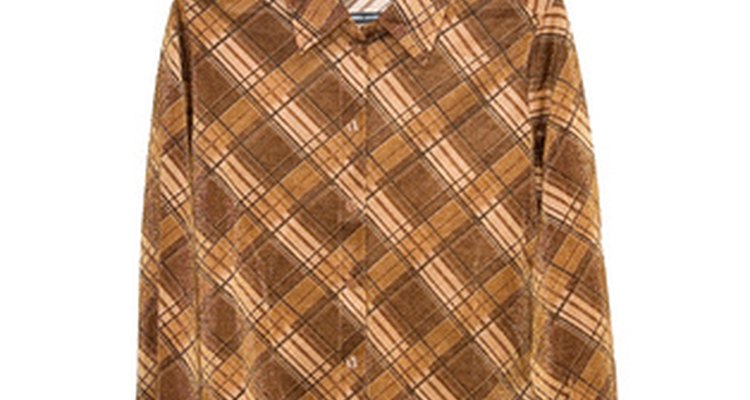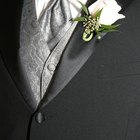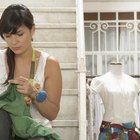
Often, worn-out articles of clothing are really only worn-out in the most stressed fabric areas. A good-quality garment may become worn or permanently dingy around areas that are close to the skin, such as the neck edge or areas that come into contact with other surfaces, such as the sleeve hems. A well worn dress shirt, for example, is likely to look its worst at the collar and cuffs. Rather than purchasing a brand new shirt, you can spruce up an old favorite by replacing the cuffs and collar.
Take the men's dress shirt and turn it inside out. Locate the stitching between the cuffs and sleeve ends, and remove it with the seam ripper. Do the same to the collar.
Unfold the cuffs and collar, and locate the stitching that attaches them to the body of the shirt. Remove it with the seam ripper. Be careful not to damage the fabric.
Turn the cuffs and collar inside out. Take apart the side seams. You should have twoseparate cuff pieces and two separate collar pieces. Mark on the fabric which edges attach to the garment.
Measure the seam allowances and fold placements on the cuffs and collar. Write these down on a sheet of paper for later reference.
Lay the cuffs and collar out on top of an ironing board. Iron all pieces completely flat.
Lay out a single layer of your new dress shirt fabric, which can match the original shirt fabric or provide a contrasting color and pattern. Pin the collar and cuff pieces to the fabric.
Cut around the cuff and collar pieces, so that you have four new pieces. Unpin the old cuff and collar pieces.
Fold under one of the bottom edges of the collar pieces, using the fold measurement you took in Step 4. Iron the fold flat.
Place the new collar pieces together, right sides touching. Pin the top and side edges together.
Sew the top and side edges together, using the seam allowance you measured in Step 4. Turn the collar right side out.
Take your dress shirt. Pin the unfolded bottom edge of the collar to the neck of the shirt, right sides together. Sew the edges together, using the seam allowance from Step 4.
Pull the folded bottom edge of the collar over the seam allowances and pin it to the stitching line. Slipstitch the folded edge to the shirt. Iron the collar flat.
Take the cuff pieces. Pin the side seam of each cuff piece together and sew the side seams, using the seam allowance measurement you recorded earlier. Iron the seam allowances open.
Fold the cuff pieces in half, wrong sides together. Fold under one edge on each cuff, using the fold measurement you recorded earlier. Iron the folds flat.
Pin the unfolded edges of the cuffs to the sleeve ends of the dress shirt, right sides together. Sew the cuffs to the sleeve ends, using the seam allowance measurement you recorded earlier.
Pull the folded edges of the cuffs over the seam allowances and pin them to the stitching line. Slipstitch the folded edges to the sleeves. Iron the cuffs.
Related Articles

How to Fix a Fraying Cuff on a Work ...

How to Sew a Gusset on a Sleeve

How to Make Tank Tops Out of T-Shirts

How to Cut a Denim Jacket Into a Vest

How to Make a French Cuff

How to Get the Creases Out of a New ...

How to Hem a Shirt Collar

How to Make a Men's Waistcoat

How to Make a Child's Graduation Gown

How to Tailor a Button-Down Shirt for a ...

How to Fold a Dress Shirt to Avoid ...

How to Fix Cuts in Polyester Clothes

How to Whiten Chiffon

How to Alter a Boxy Jacket

How to Marinate a Steak Texas Style

Can You Iron Tuxedo Pants?

How to Hang Sweaters So They Don't Get ...

How to Locate a Missing Person in ...

Turning a Shirt Into a Tank Top for Men

How to Change a Band on a Stauer Watch
References
- "Shirtmaking: Developing Skills for Fine Sewing;" David Page Coffin; 1998.
- "The Complete Book of Sewing Shortcuts"; Claire B. Shaeffer
Writer Bio
A writer with a Bachelor of Science in English and secondary education, but also an interest in all things beautiful, Melissa J. Bell has handed out beauty and fashion advice since she could talk -- and for the last six years, write for online publications like Daily Glow and SheBudgets.
Photo Credits
shirt image by dinostock from Fotolia.com